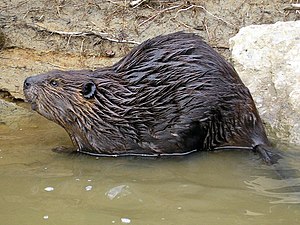Canadian beaver
| Canadian beaver | ||||||||||||
|---|---|---|---|---|---|---|---|---|---|---|---|---|

Canadian beaver ( Castor canadensis ) |
||||||||||||
| Systematics | ||||||||||||
|
||||||||||||
| Scientific name | ||||||||||||
| Castor canadensis | ||||||||||||
| Kuhl , 1820 |
The Canadian beaver or American beaver ( Castor canadensis ) belongs to the genus beaver ( Castor ) from the order of rodents (Rodentia). It is closely related to the European beaver ( Castor fiber ) and some zoologists consider both to be subspecies of only one species . However, it is usually larger and has 40 chromosomes, while the European beaver has 48.
The Canadian beaver is the national animal of Canada and is depicted on the Canadian five cent coin. However, it is considered a pest in some parts of Canada.
Occurrence
The Canadian beaver was native to all of Canada except the northernmost areas, all of the United States except Nevada , most of Florida , northern California, and some adjacent arid areas. It was also found in a narrow strip of northern Mexico , where it is now as good as extinct. It has also been eradicated in some parts of the USA, such as large parts of Delaware , eastern Massachusetts or the western half of Ohio . In a total of 15 out of 49 states in the USA in which it originally appeared, there were no more beavers, mainly due to excessive hunting. Today it is represented again, at least in smaller populations, through natural spreading and reintroduction in all states in which it originally occurred. The IUCN therefore classifies it as safe.
When Canadian beavers settled in Tierra del Fuego in 1946 with the aim of using fur animals, the beaver quickly spread in this area due to the lack of predators.
In addition, the Canadian beaver is now found in Europe in parts of Finland and in Kamchatka through resettlement .
Way of life
The way of life of the Canadian beaver hardly differs from that of the European beaver .
Beaver and human
During the period of European colonization, beaver hair ( castor hats ) and beaver fur quickly became a sought-after commodity. At the height of the beaver fur trade, around 200,000 beaver pelts were exported to Europe every year. Around 1900, the trade in beaver furs fell sharply, not only because beavers went out of fashion, but because there were fewer and fewer animals in all of North America. In many areas of North America there were no more beaver populations in the first half of the 20th century.
Only around 1930 did a rethink in Canada slowly begin. Beaver hunting was banned for many years and the populations recovered. Beavers have even been reintroduced in regions of Canada where they were eradicated, so that today there is a healthy beaver population that is also hunted almost everywhere in Canada.
In large parts of Canada, there are few conflicts with humans due to the sparse population. But where it becomes a nuisance to people due to the felling and gnawing of trees as well as dam building, one does not shy away from fighting.
In Germany , Canadian beavers may not be bred, offered, offered for sale, given or kept in stock for sale by private individuals.
Individual evidence
- ↑ Christopher B. Anderson, Amy D. Rosemond: Beaver invasion alters terrestrial subsidies to subantarctic stream food webs. In: Hydrobiologia. Vol. 652, No. 1, June 2009, ISSN 0018-8158 , pp. 349-361, doi: 10.1007 / s10750-010-0367-8 .
- ↑ Martin Sell: Biber in Europa 2003. Graphic Wikimedia Commons , June 13, 2004.
- ^ Biber in Russland In: Bibermanagement.de .
- ^ Emil Brass : From the realm of fur publishers of the "Neue Pelzwaren-Zeitung and Kürschner-Zeitung", Berlin 1911, p. 597.
- ↑ § 3 of the Federal Species Protection Ordinance
Web links
- Castor canadensis in the endangered Red List species the IUCN 2006. Posted by: MacDonald & Cook, 2000. Retrieved on 12 May, 2006.
- Videos on Castor canadensis published by the Institute for Scientific Film .
